Novel Modelling Approach for the Calculation of the Loading Performance of Charging Stations for E-Trucks to Represent Fleet Consumption
Abstract
1. Introduction
1.1. Literature Review
- Simple function with few parameters.
- The computational effort when using the method should be low.
- Easy adaptability to other BMS or alternative technologies.
- High accuracy.
- Determination of exact charging times for given SOC rates and charging infrastructure solutions.
- Impact of superposition of multiple time-shifted charging events in terms of power consumption.
- Use in fleet management systems for the integration of e-trucks in logistics fleets.
1.2. Research Questions
- How can HPC operations for e-trucks in terms of critical parameters (charging time, charging amount, SOC status) be calculated as easily as possible for fleet management tools?
- What accuracies can be achieved here compared to real-life data?
- Can the method be adapted to other charging characteristics?
- Which statements regarding the superposition of several charging processes can be derived from the model?
1.3. Logistic as a Function
2. Materials and Methods
2.1. Data Basis
2.2. Analytical Approach
- Flexibility in terms of battery capacity.
- Flexibility with regard to the nominal capacity of charging stations.
- Determination of the instantaneous charging capacity of an electric truck.
- Determination of the state of charge of an electric truck.
- Applicability for the calculation of the characteristic values for the HUB design with regard to electric truck fleets.
- Applicability for the calculation of charging times for electric truck fleets.
- Determination of parameters for intelligent load management for electric truck fleets.
2.3. Identify
2.4. Finding the Correction Function
3. Results
3.1. Applying the Method
3.2. Calculate the Correction Function
3.3. Accuracy
3.4. Simulation Results
4. Discussion
4.1. Use Case E-Trucks
4.2. Gradient
4.3. Accuracy
4.4. Superposition of Several Charging Processes
5. Conclusions
Author Contributions
Funding
Institutional Review Board Statement
Informed Consent Statement
Data Availability Statement
Acknowledgments
Conflicts of Interest
Nomenclature
| HPC | high-power charging | |
| SOC | state of charge | |
| LCA | life cycle assessment | |
| C-rates | factor of charging power to nominal capacity | [h−1] |
| AI | artificial intelligence | |
| TCO | total cost of ownership | |
| function for the TCO | ||
| energy | ||
| , | mapping of the total infrastructure | |
| , | power at time | [kW] |
| , | mapping for the number and types of trucks in the fleet | |
| rated capacities of each fuelling option | [kW] | |
| maximum expected total fuelling capacity | [kW] | |
| nominal capacities of the trucks’ energy storage systems | [kWh] | |
| trips to be made by the fleet | ||
| stopping times of the fleet for operation | [s] | |
| refuelling times | [s] | |
| service function of the fleet technology considered in the scenario | ||
| Timestep | [s] | |
| Function to describe the charging power away from the starting point at | [kW] | |
| time at | [s] | |
| function to describe battery capacity at time from start at | [kWh] | |
| charging power at time from start at | [kW] | |
| function to describe battery capacity at time from start at | [kWh] | |
| test function | ||
| correction function to achieve the desired battery capacity | ||
| the calculated maximum reached energy capacity | [kWh] | |
| homotopy | ||
| parameterized correction function | ||
| lowest parameterized correction functions | ||
| highest parameterized correction functions | ||
| lowest nominal capacities used | [kWh] | |
| Highest nominal capacities used | [kWh] | |
| correction coefficients | ||
| vector with powers of | ||
| vector with powers of | ||
| , | diversification factor | |
| current power at the i-th charging point | [kW] | |
| is the nominal power at the i-th charging point | [kW] |
References
- European Commission. Sustainable and Smart Mobility Strategy—Putting European Transport on Track for the Future. In Communication from the Commission to the European Parlament, the Council the European Economic and Social Committee and the Committee of Regions; European Commission: Brussels, Belgium, 2020. [Google Scholar]
- Marmiroli, B.; Venditti, M.; Dotelli, G.; Spessa, E. The transport of goods in the urban environment: A comparative life cycle assessment of electric, compressed natural gas and diesel light-duty vehicles. Appl. Energy 2020, 260, 114236. [Google Scholar] [CrossRef]
- Garcia, R.; Freire, F. A review offleet-based life-cycle approaches focusing on energy andenvironmental impacts of vehicles. Renew. Sustain. Energy Rev. 2017, 79, S935–S945. [Google Scholar] [CrossRef]
- Yu, A.; Wei, Y.; Chen, W.; Peng, N.; Peng, L. Life cycle environmental impacts and carbon emissions: A case study of electric and gasoline vehicles in China. Transp. Res. Part D Transp. Environ. 2018, 65, 409–420. [Google Scholar] [CrossRef]
- Szymczyk, K.; Kadlubek, A. Challenges in general cargo distribution strategy in urban logistics—Comparative analysis of the biggest logistics operators in EU. Transp. Res. Procedia 2019, 39, S525–S533. [Google Scholar] [CrossRef]
- Quak, H.; Nesterova, N.; van Rooijen, T. Possibilities and Barriers for Using Electric-powered Vehicles in City Logistics Practice. Transp. Res. Procedia 2016, 12, 157–169. [Google Scholar] [CrossRef]
- Tsakalidis, A.; Krause, J.; Julea, A.; Peduzzi, E.; Pisoni, E.; Thiel, C. Electric light commercial vehicles: Are they the sleeping giant of electromobility? Transp. Res. Part D Transp. Environ. 2020, 86, 102421. [Google Scholar] [CrossRef]
- Teoh, T.; Kunze, O.; Teo, C.-C. Methodology to Evaluate the Operational Suitability of Electromobility Systems for Urban Logistics Operations. Transp. Res. Procedia 2016, 12, 288–300. [Google Scholar] [CrossRef]
- megaWATT Logistics. Available online: https://megawattlogistics.boku.ac.at/ (accessed on 9 June 2021).
- Gruosso, G.; Mion, A.; Gajani, G.S. Forecasting of electrical vehicle impact on infrastructure: Markov chains model of charging stations occupation. eTransportation 2020, 6, 100083. [Google Scholar] [CrossRef]
- Bizzarri, F.; Bizzozero, F.; Brambilla, A.; Gruosso, G.; Gajani, G.S. Electric vehicles state of charge and spatial distribution forecasting: A high-resolution model. In Proceedings of the IECON 2016—42nd Annual Conference of the IEEE Industrial Electronics Society, Florence, Italy, 23–26 October 2016; pp. 3942–3947. [Google Scholar]
- Heubner, C.; Reuber, S.; Seeba, J.; Marcinkoski, P.; Nikolowski, K.; Schneider, M.; Wolter, M.; Michaelis, A. Applica-tion-oriented modeling and optimization of tailored Li-ion batteries using the concept of Diffusion Limited C-rate. J. Power Source 2020, 479, 228704. [Google Scholar] [CrossRef]
- Angrisani, G.; Canelli, M.; Roselli, C.; Sasso, M. Integration between electric vehicle charging and micro-cogeneration system. Energy Convers. Manag. 2015, 98, 115–126. [Google Scholar] [CrossRef]
- Du, J.; Mo, X.; Li, Y.; Zhang, Q.; Li, J.; Wu, X.; Lu, L.; Ouyang, M. Boundaries of high-power charging for long-range battery electric car from the heat generation perspective. Energy 2019, 182, 211–223. [Google Scholar] [CrossRef]
- Ragone, M.; Yurkiv, V.; Ramasubramanian, A.; Kashir, B.; Mashayek, F. Data driven estimation of electric vehicle battery state-of-charge informed by automotive simulations and multi-physics modeling. J. Power Source 2021, 483, 229108. [Google Scholar] [CrossRef]
- Babaeiyazdi, I.; Rezaei-Zare, A.; Shokrzadeh, S. State of charge prediction of EV Li-ion batteries using EIS: A machine learning approach. Energy 2021, 223, 120116. [Google Scholar] [CrossRef]
- Sidhu, M.S.; Ronanki, D.; Williamson, S. State of Charge Estimation of Lithium-Ion Batteries Using Hybrid Machine Learning Technique. In Proceedings of the IECON 2019—45th Annual Conference of the IEEE Industrial Electronics Society, Lisbon, Portugal, 14–17 October 2019; Volume 1, pp. 2732–2737. [Google Scholar]
- Gora, P. Designing urban areas using traffic simulations, artificial intelligence and acquiring feedback from stakeholders. Transp. Res. Procedia 2019, 41, 532–534. [Google Scholar] [CrossRef]
- Lee, J.; Nam, O.; Cho, B. Li-ion battery SOC estimation method based on the reduced order extended Kalman filtering. J. Power Source 2007, 174, 9–15. [Google Scholar] [CrossRef]
- Baccouche, I.; Jemmali, S.; Manai, B.; Omar, N.; Ben Amara, N.E. Improved OCV Model of a Li-Ion NMC Battery for Online SOC Estimation Using the Extended Kalman Filter. Energies 2017, 10, 764. [Google Scholar] [CrossRef]
- Sreedhar, R.; Karunanithi, K. Design, simulation analysis of universal battery management system for EV applications. Mater. Today Proc. 2021, in press. [Google Scholar] [CrossRef]
- Skugor, B.; Deur, J. A bi-level optimization framework for electric vehicle fleet charging management. Appl. Energy 2016, 184, 1332–1342. [Google Scholar] [CrossRef]
- Hu, J.; Morais, H.; Sousa, T.; Lind, M. Electric vehicle fleet management in smart grids: A review of services, optimization and control aspects. Renew. Sustain. Energy Rev. 2016, 56, 1207–1226. [Google Scholar] [CrossRef]
- El Idi, M.M.; Karkri, M.; Tankari, M.A. A passive thermal management system of Li-ion batteries using PCM composites: Experimental and numerical investigations. Int. J. Heat Mass Transf. 2021, 169, 120894. [Google Scholar] [CrossRef]
- Jünemann, R. Materialfluß und Logistik. Systemtechnische Grundlagen mit Praxisbeispielen; Springer: Berlin/Heidelberg, Germany, 1989. [Google Scholar] [CrossRef]
- Ellram, L.M. Total cost of ownership: An analysis approach for purchasing. Int. J. Phys. Distrib. Logist. Manag. 1995, 25, 4–23. [Google Scholar] [CrossRef]
- Ghandriz, T.; Jacobson, B.; Laine, L.; Hellgren, J. Optimization data on total cost of ownership for conventional and battery electric heavy vehicles driven by humans and by automated driving systems. Data Brief 2020, 30, 105566. [Google Scholar] [CrossRef]
- Hagman, J.; Ritzén, S.; Stier, J.J.; Susilo, Y. Total cost of ownership and its potential implications for battery electric vehicle diffusion. Res. Transp. Bus. Manag. 2016, 18, 11–17. [Google Scholar] [CrossRef]
- López-Ibarra, J.A.; Gaztañaga, H.; Saez-De-Ibarra, A.; Camblong, H. Plug-in hybrid electric buses total cost of ownership optimization at fleet level based on battery aging. Appl. Energy 2020, 280, 115887. [Google Scholar] [CrossRef]
- Jänich, K. Topologie; Springer: Berlin/Heidelberg, Germany, 1999. [Google Scholar]
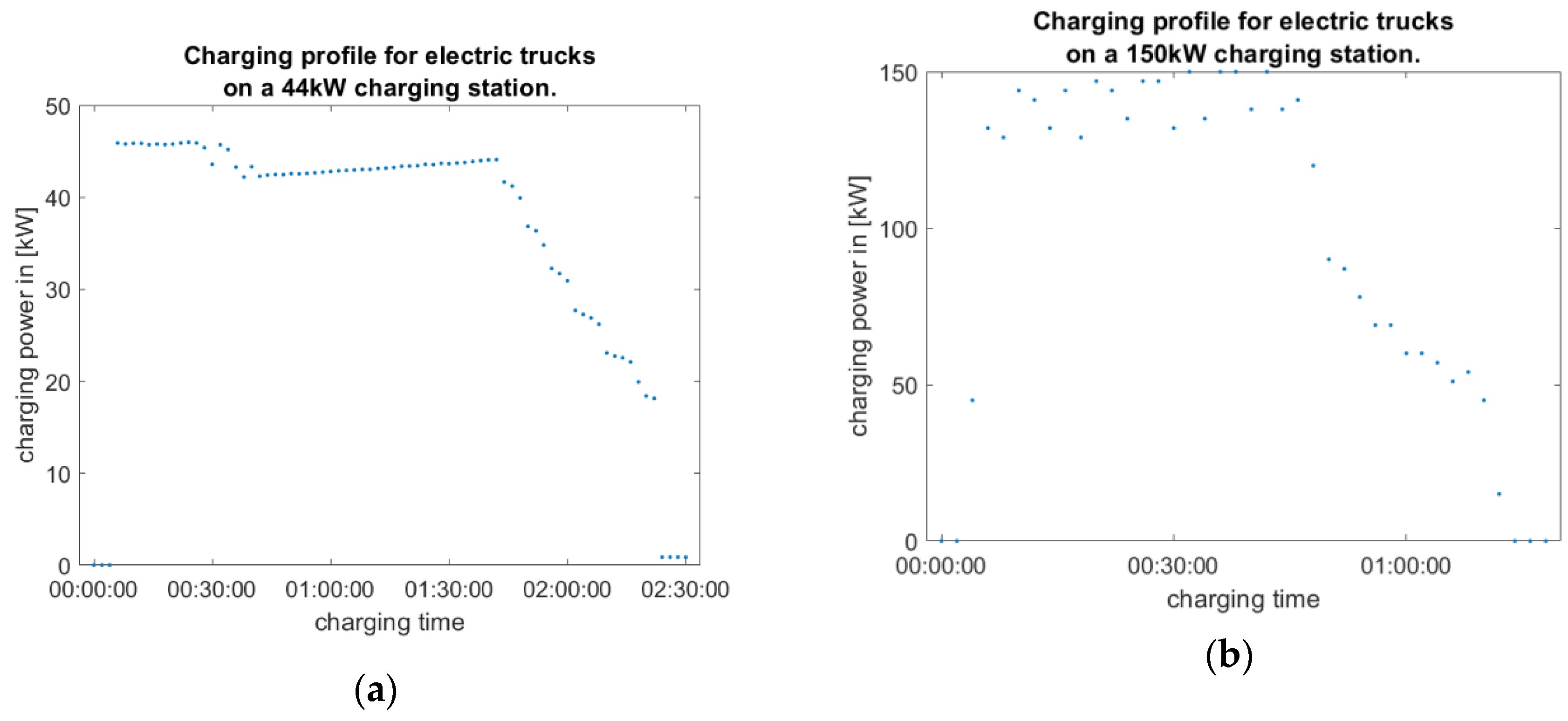
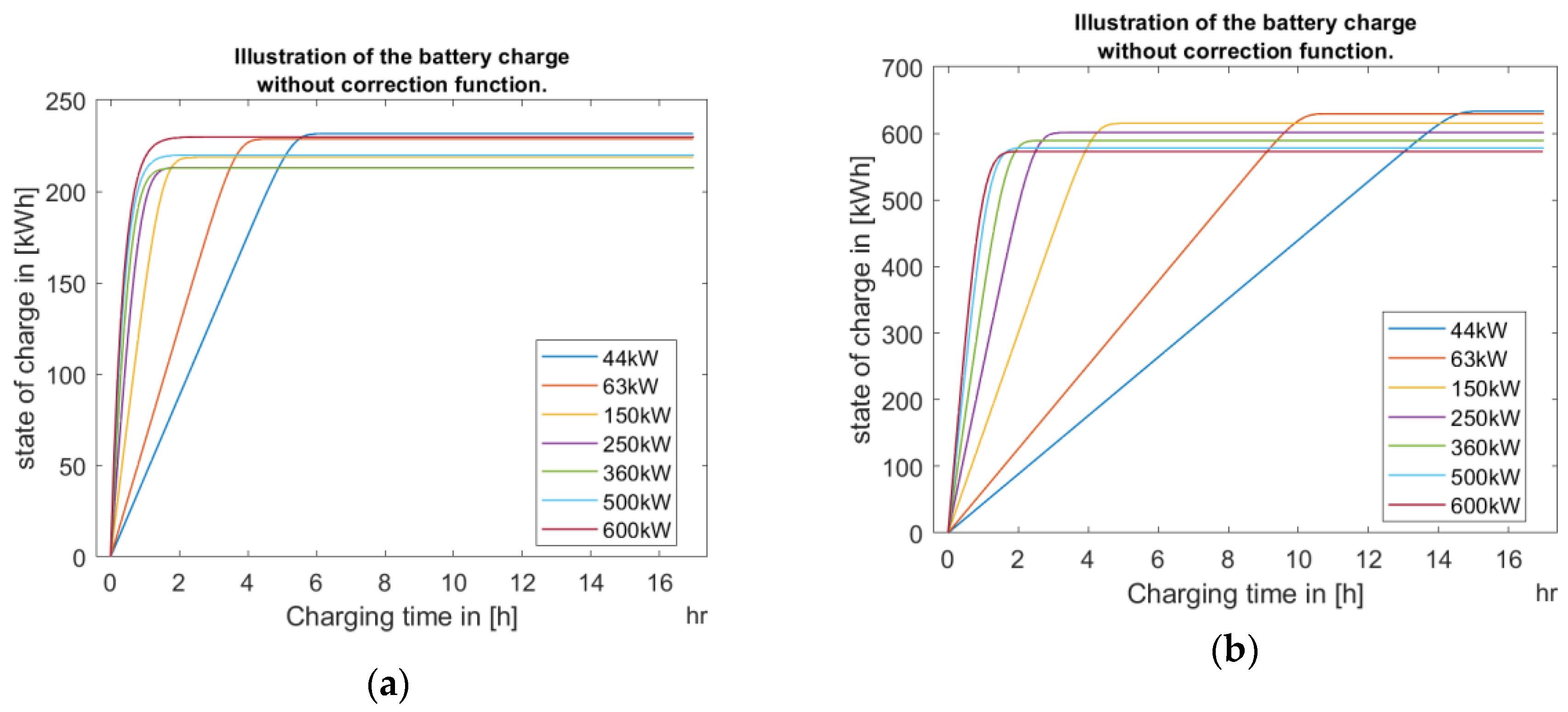


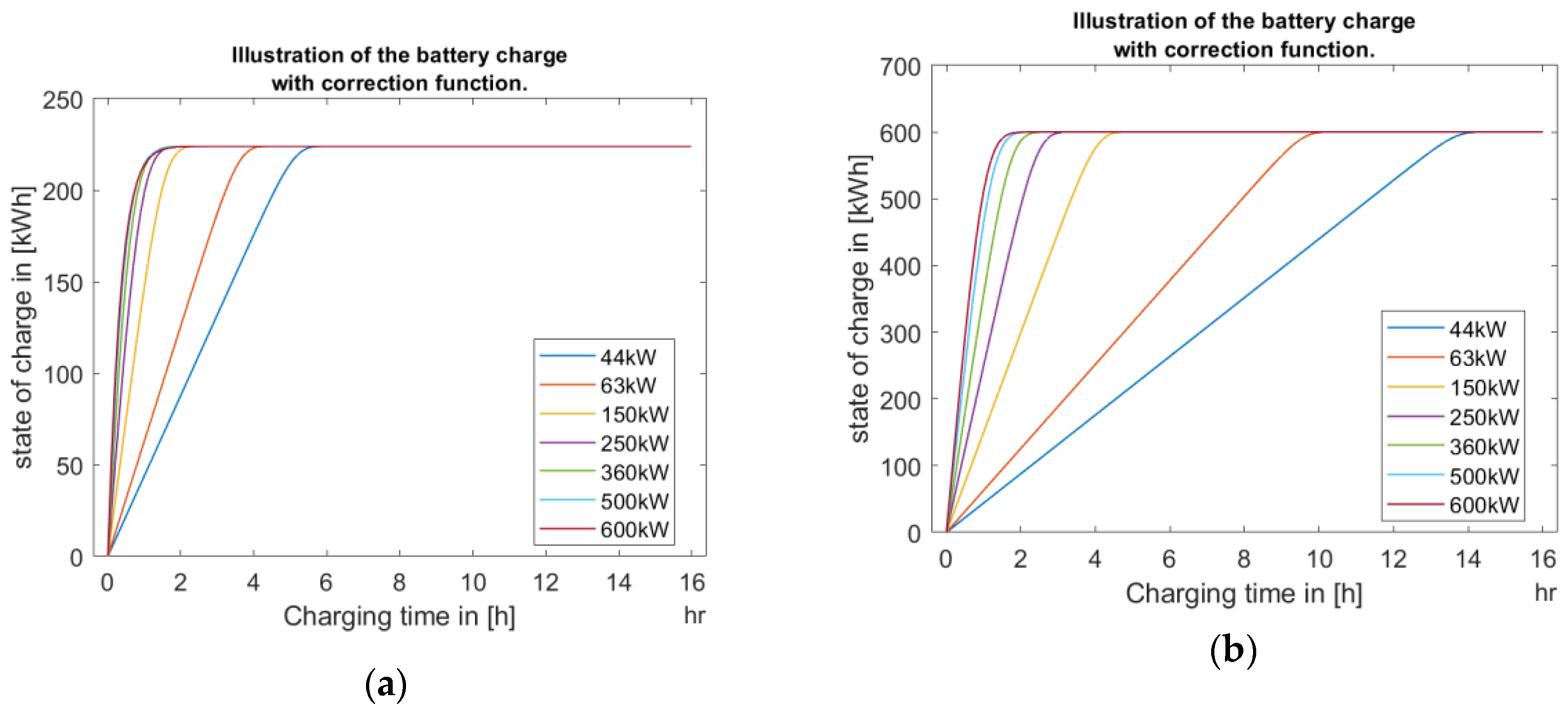
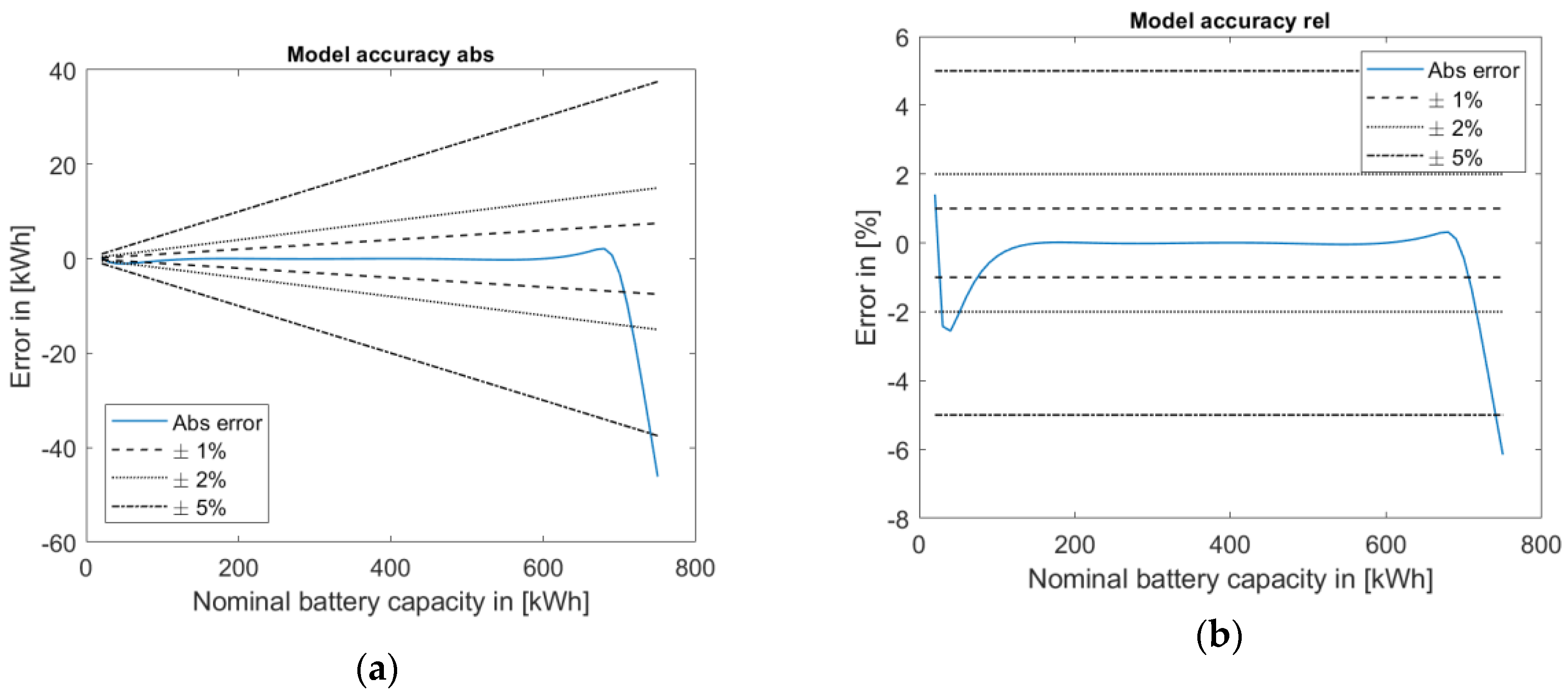
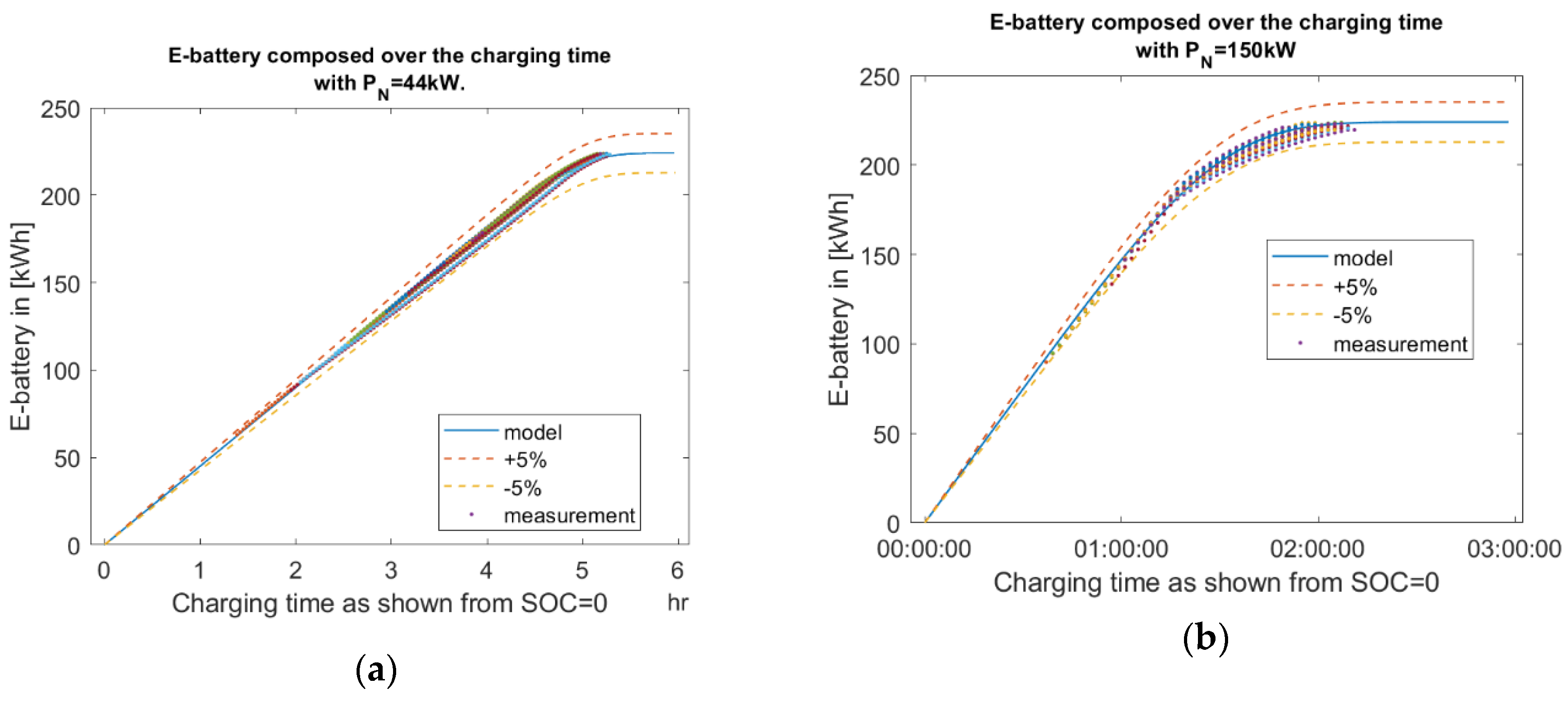
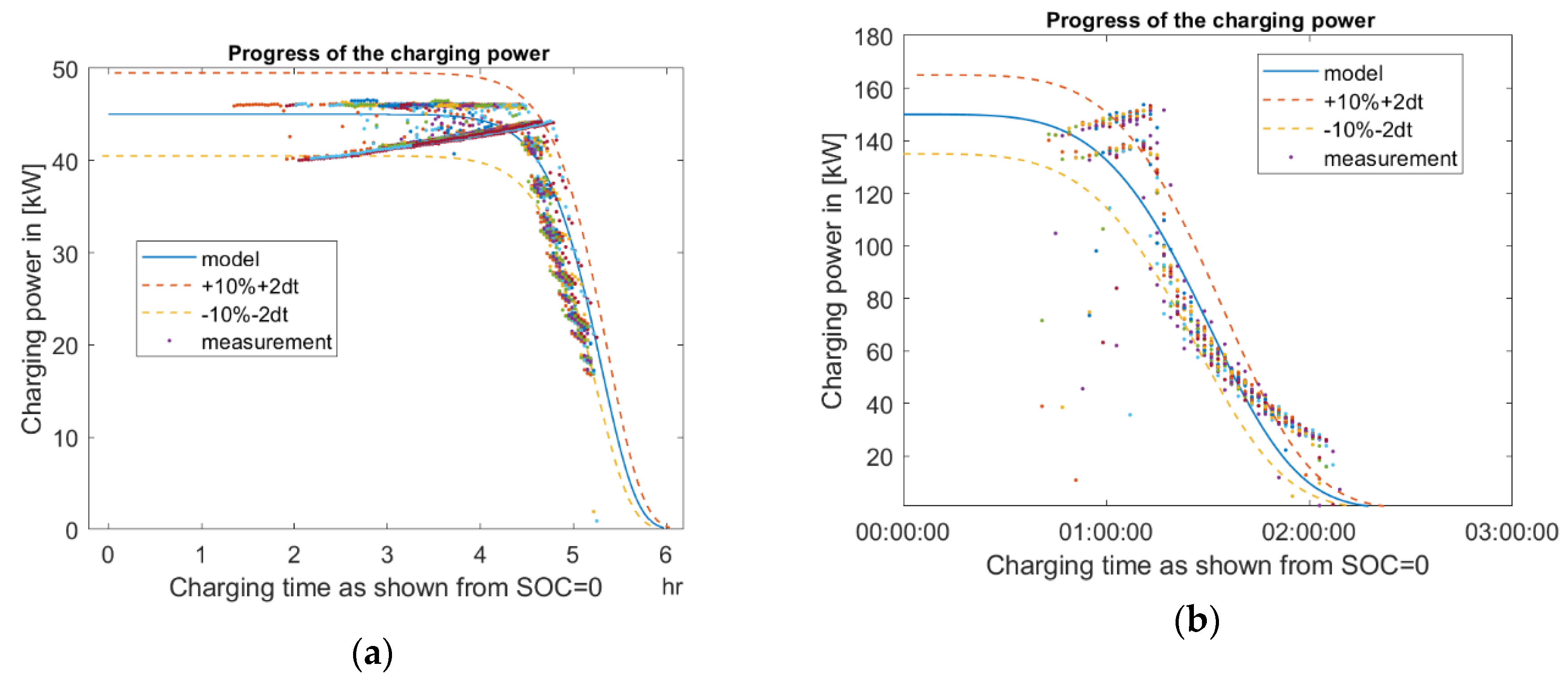
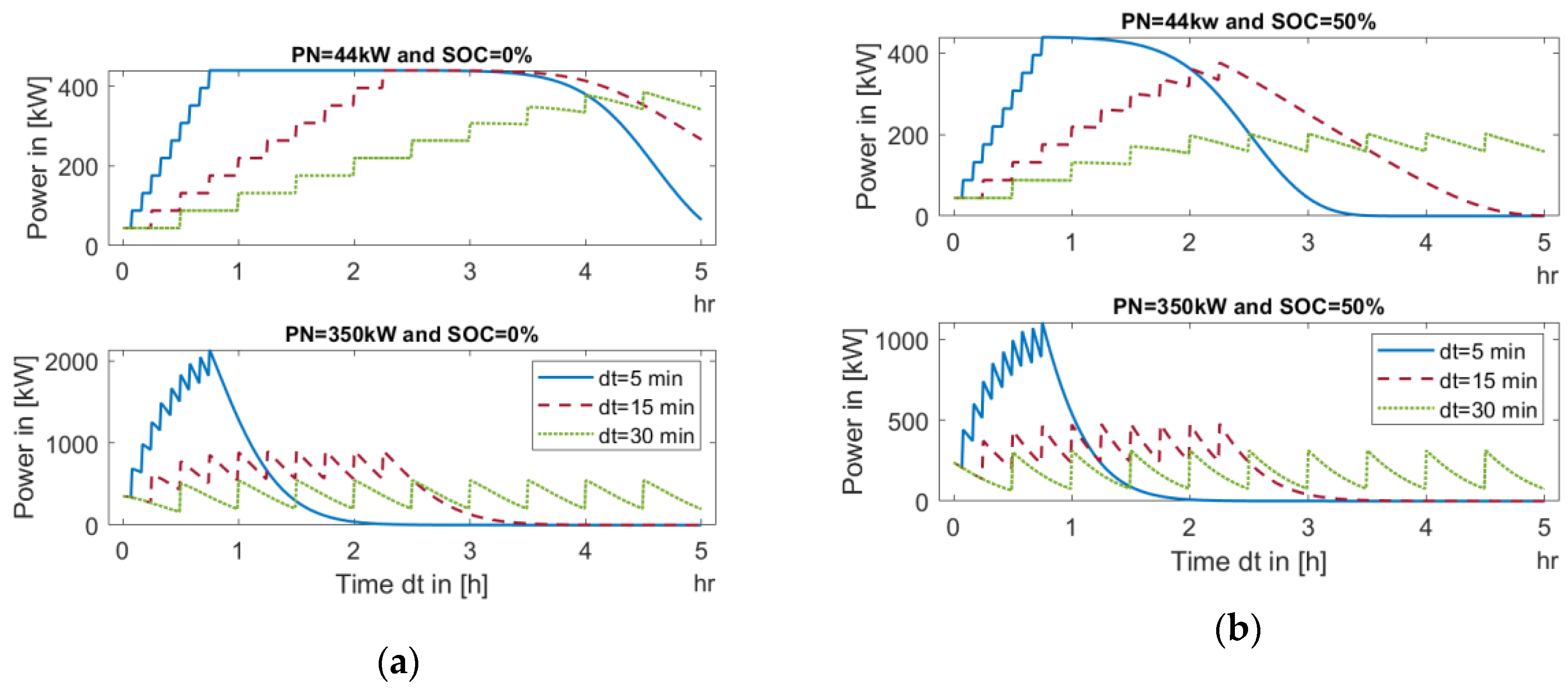
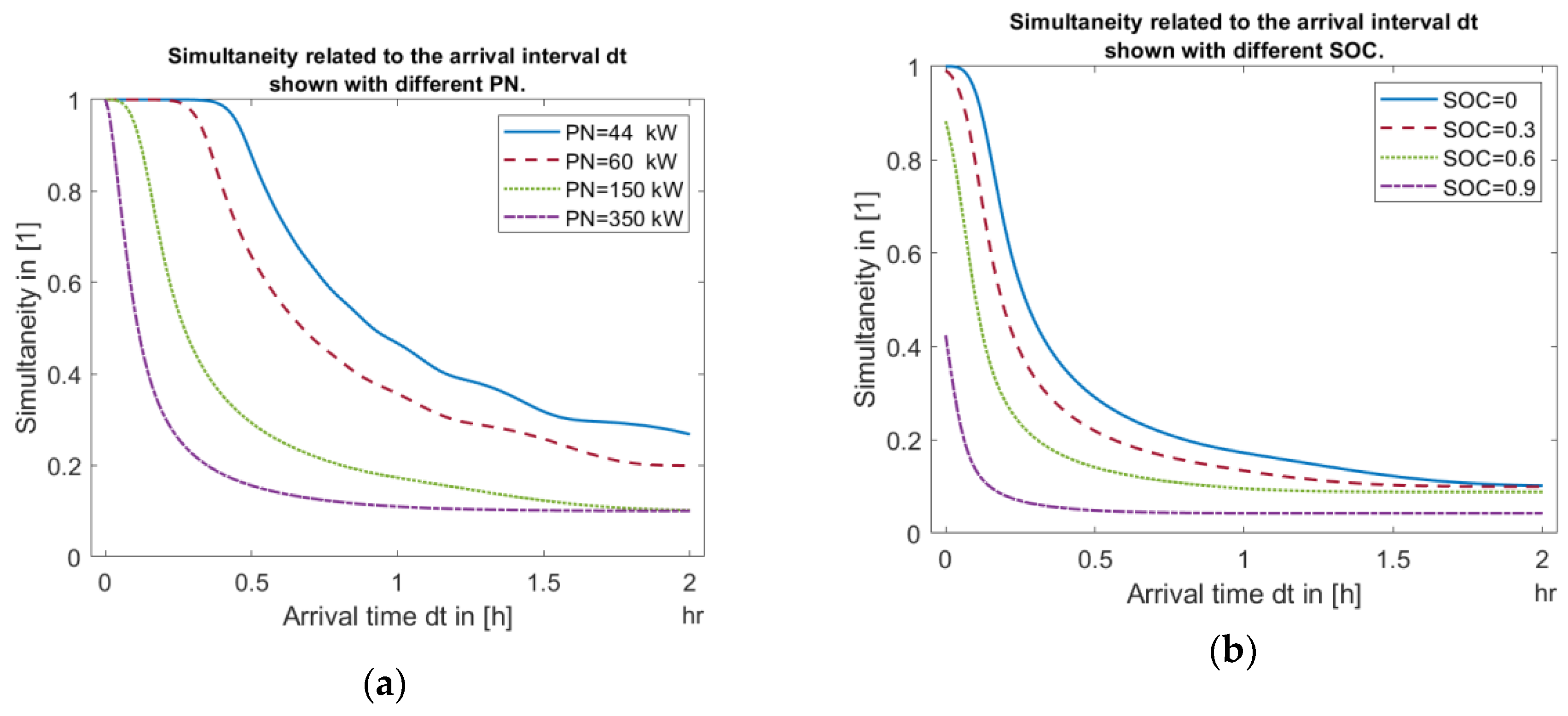
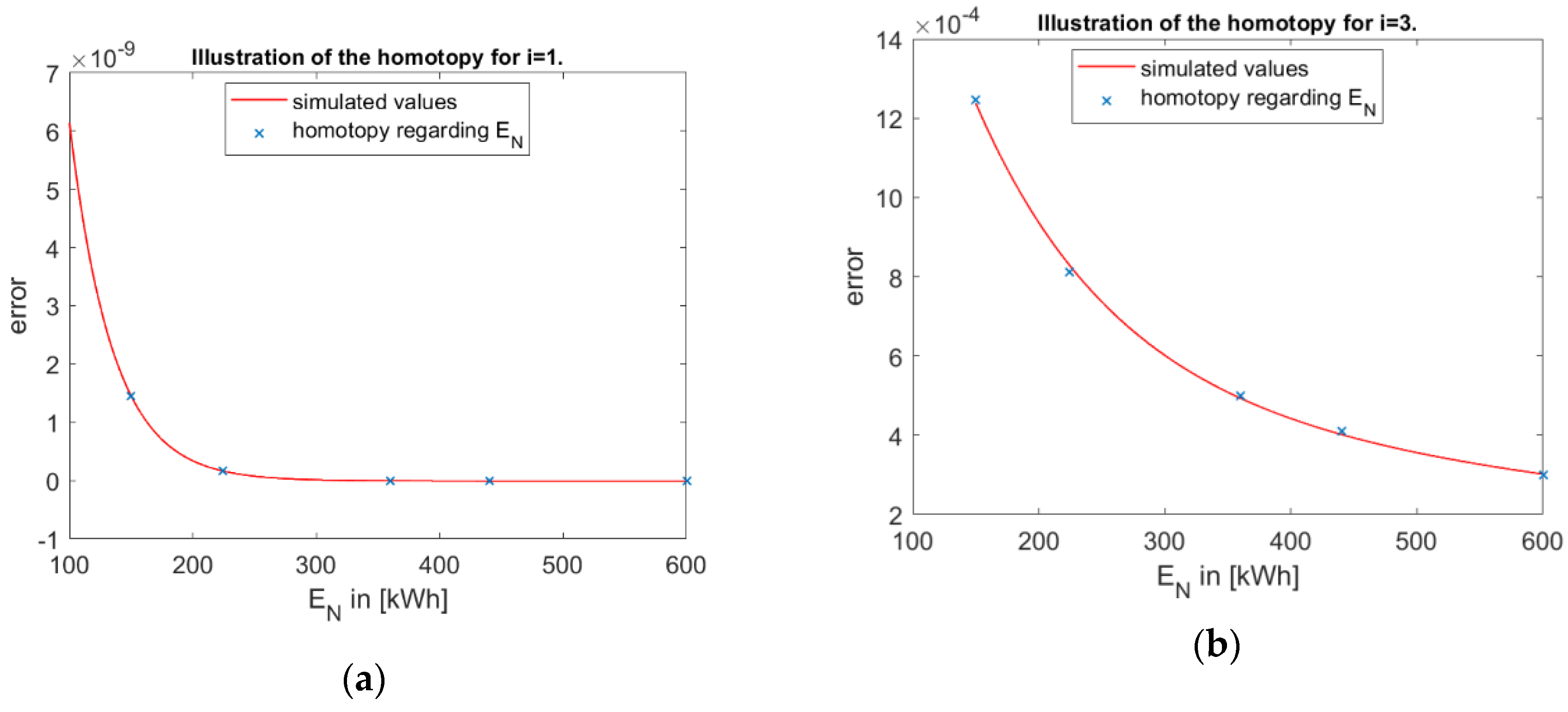
Publisher’s Note: MDPI stays neutral with regard to jurisdictional claims in published maps and institutional affiliations. |
© 2021 by the authors. Licensee MDPI, Basel, Switzerland. This article is an open access article distributed under the terms and conditions of the Creative Commons Attribution (CC BY) license (https://creativecommons.org/licenses/by/4.0/).
Share and Cite
Märzinger, T.; Wöss, D.; Steinmetz, P.; Müller, W.; Pröll, T. Novel Modelling Approach for the Calculation of the Loading Performance of Charging Stations for E-Trucks to Represent Fleet Consumption. Energies 2021, 14, 3471. https://doi.org/10.3390/en14123471
Märzinger T, Wöss D, Steinmetz P, Müller W, Pröll T. Novel Modelling Approach for the Calculation of the Loading Performance of Charging Stations for E-Trucks to Represent Fleet Consumption. Energies. 2021; 14(12):3471. https://doi.org/10.3390/en14123471
Chicago/Turabian StyleMärzinger, Thomas, David Wöss, Petra Steinmetz, Werner Müller, and Tobias Pröll. 2021. "Novel Modelling Approach for the Calculation of the Loading Performance of Charging Stations for E-Trucks to Represent Fleet Consumption" Energies 14, no. 12: 3471. https://doi.org/10.3390/en14123471
APA StyleMärzinger, T., Wöss, D., Steinmetz, P., Müller, W., & Pröll, T. (2021). Novel Modelling Approach for the Calculation of the Loading Performance of Charging Stations for E-Trucks to Represent Fleet Consumption. Energies, 14(12), 3471. https://doi.org/10.3390/en14123471





